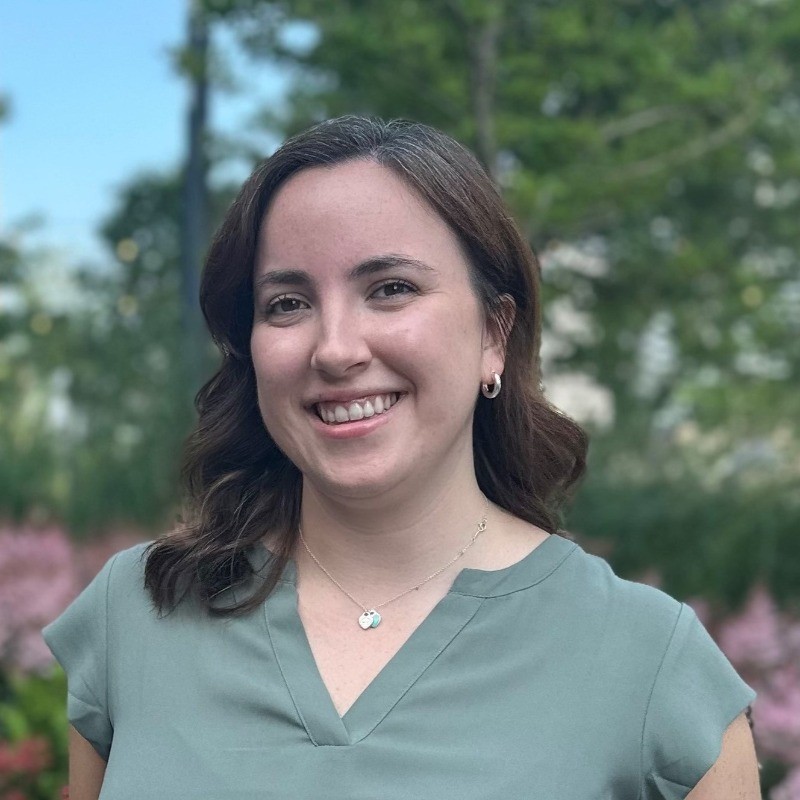Every business aims to address the needs of its customers and grow its market reach, both locally and globally. One critical aspect of achieving this is by inviting vendors to submit their proposals, showcasing how their products or services can help the company meet its objectives. This is done through a “request for proposal” (RFP).
Understanding the intricacies of creating a tailored RFP template can significantly impact the outcomes of your vendor selection process. This article will provide valuable insights into creating a comprehensive RFP template.
Request for Proposal (RFP) Explained
An RFP is a formal document that outlines a company’s specific project requirements and invites vendors, contractors, or service providers to submit their proposals detailing how they can address these needs.
The company issuing the RFP will then evaluate the submitted bids based on their ability to fulfil the project requirements and deliver the desired results.
RFPs are not limited to the private sector; they are also widely used by government agencies seeking vendors to provide solutions for various projects. These documents help create a transparent and structured bidding process, ensuring that vendors address the customers’ pain points effectively.
For instance, if a company is looking to enhance its IT infrastructure to bolster its digital marketing efforts, it may issue an RFP to solicit proposals from qualified digital marketing agencies.
Free Templates
Following are the request for proposal templates:
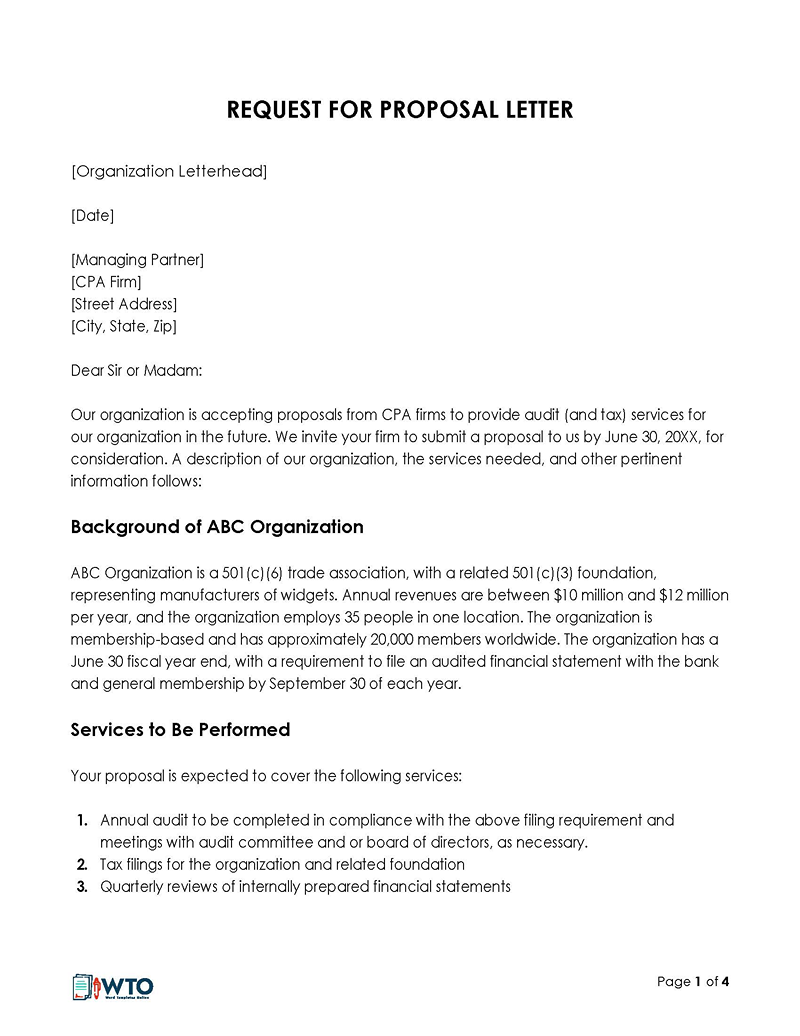





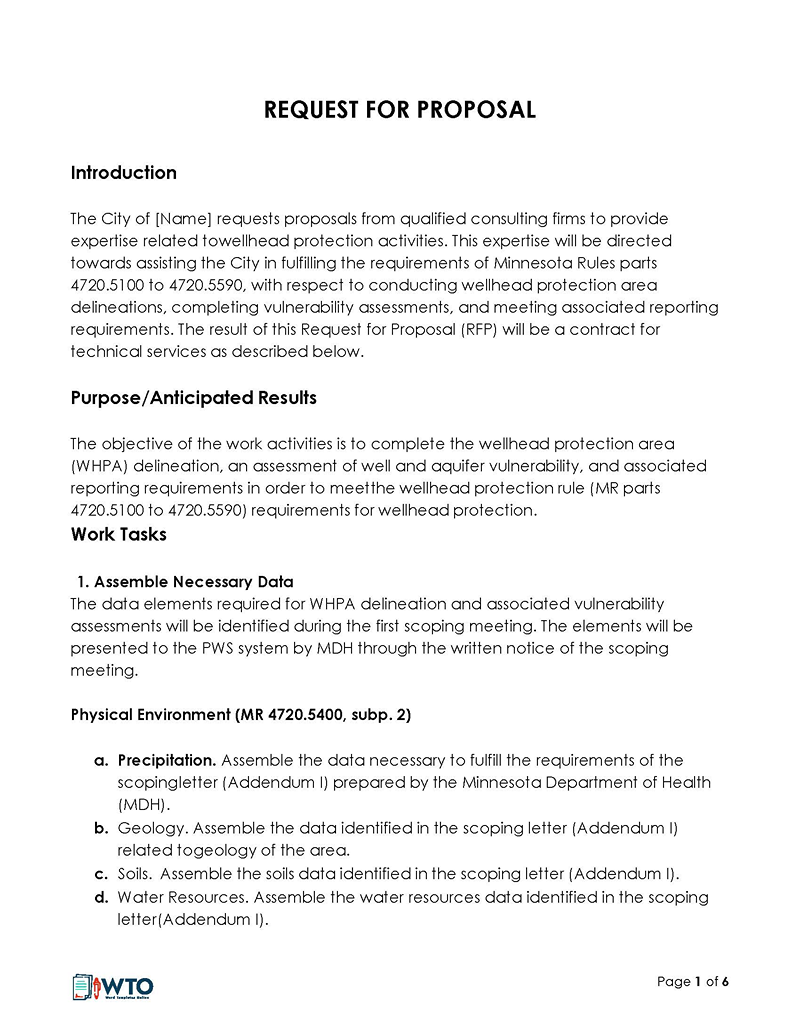
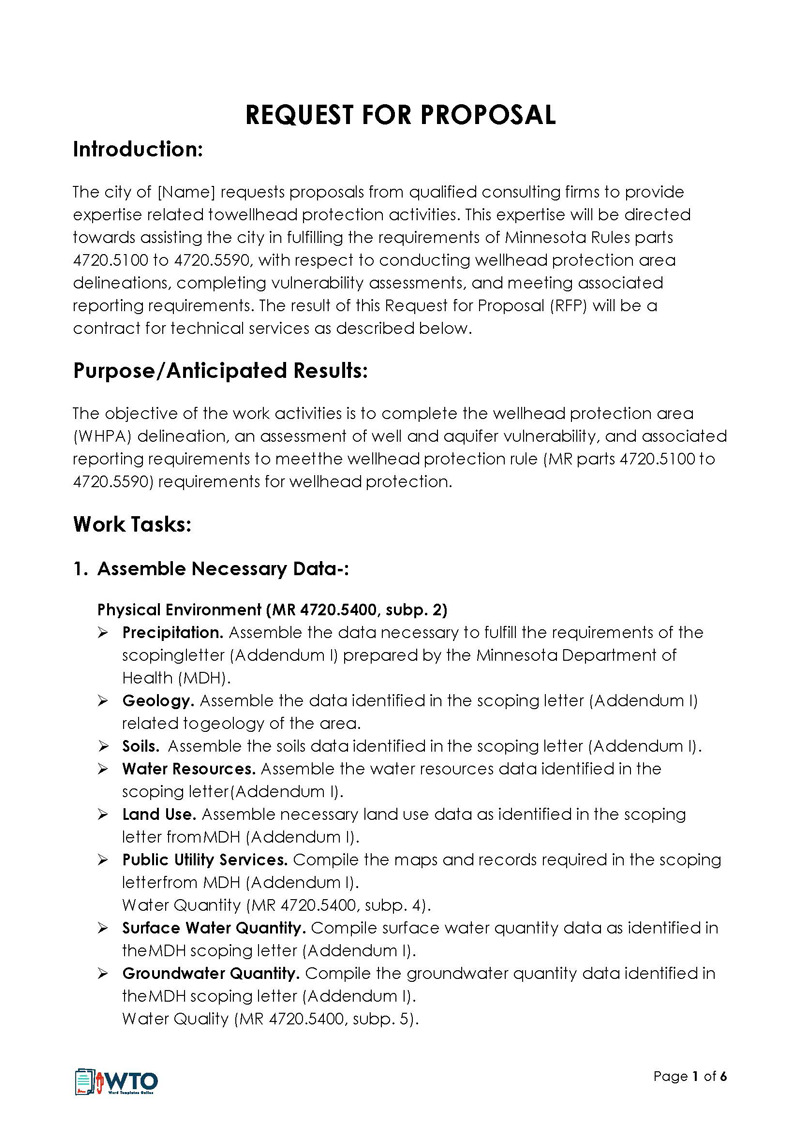


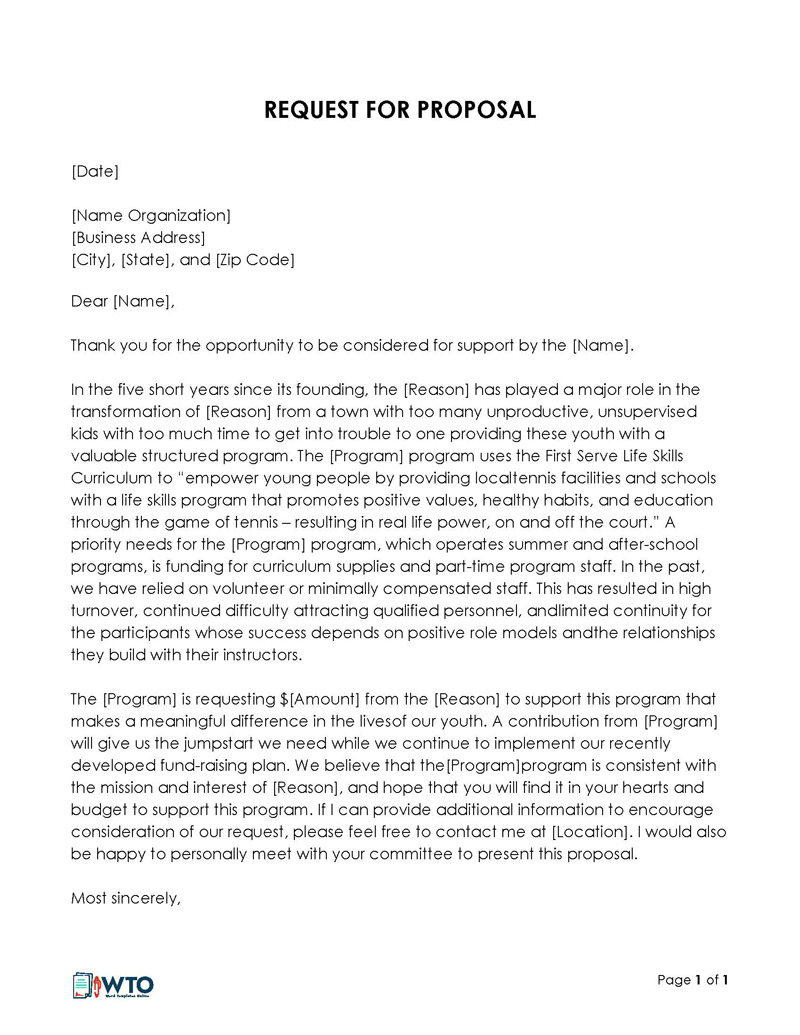

The Importance and Benefits of RFPs
Utilising requests for proposals in business operations offers numerous advantages to companies seeking the most suitable vendors for their projects.
Some key benefits of RFPs include:
- Vendor Selection: RFPs help companies announce their projects and attract competent vendors who have the skills and expertise to complete the job successfully.
- Variety of Solutions: Issuing an RFP encourages multiple bids from different vendors, providing a wide array of potential solutions to a single problem. For instance, requesting proposals for a printing solution will allow your company to explore various options and find the best fit for your specific needs.
- Competitive Pricing: The competitive nature of RFPs often leads to more affordable project costs, as vendors strive to offer attractive pricing while maintaining quality solutions.
- Streamlined Decision Making: The detailed specifications within an RFP ensure that companies receive targeted proposals that align with their project scope, making the evaluation process more efficient.
- Fair and Transparent Process: RFPs help eliminate favouritism in awarding contracts by focusing on vendors’ qualifications and proposed solutions, rather than personal connections.
The RFP Process Explained
The request for proposal (REF) process typically follows a systematic approach that includes outlining the project requirements, evaluation criteria, contract terms, and bidding procedures.
Here’s a simple overview of the RFP process:
- Issuing the RFP: The company releases an RFP outlining its project needs, such as seeking a digital marketing agency to improve IT solutions and increase customer engagement.
- Proposal Submission: Qualified digital marketing agencies submit their proposals, detailing how they can help the company enhance its marketing efforts and achieve its goals.
- Evaluation and Selection: The company reviews the submitted proposals, comparing them based on their alignment with the project requirements and the company’s objectives. The most suitable vendor is then selected to carry out the project.
Roles and Responsibilities of Key Players in RFP Process
TheRFP process requires proper coordination and collaboration among stakeholders to ensure project success.
The main roles and responsibilities involved in the RFP process include:
- Consultant: The consultant is responsible for identifying and vetting qualified vendors, effectively communicating the client’s needs, and ensuring that the RFP accurately reflects these requirements.
- Procurement Professional: Procurement professionals work closely with the company to understand its specific needs and objectives, which are then incorporated into the RFP. They also communicate with vendors and oversee the project’s progress to ensure a smooth execution.
- Business Stakeholders: These individuals evaluate vendors’ responses, assessing the proposed solutions and determining which factors are crucial for the project’s success.
- CFO: The Chief Financial Officer is responsible for evaluating the cost-effectiveness and potential return on investment (ROI) of each submitted proposal, ensuring that the selected solution aligns with the company’s financial goals.
Understanding RFPs, RFQs, and RFIs
RFPs, RFQs (request for quotes), and RFIs (request for information) are essential documents used by companies to communicate their needs to potential vendors. However, they serve distinct purposes:
- RFP: The company knows the specific product or service they want and invites vendors to submit proposals on how they can meet these requirements.
- RFQ: The company is looking to compare prices and terms for a specific product or service, helping them determine the most cost-effective option.
- RFI: The company seeks more information about various products and services to understand how they can address their problems or needs.
While RFPs and RFIs are sometimes confused, there is a fundamental difference between the two. RFPs are issued when the company has a clear understanding of the requirements that vendors must meet, whereas RFIs are used when companies require more information about potential solutions before making a decision.
Essential Elements of Effective RFP
To create a comprehensive and informative RFP, it is crucial to include the following elements:
Background and introduction
Provide a brief overview of your organization and the project at hand to help bidders understand the context and determine if the project aligns with their capabilities. Include any relevant history, objectives, and challenges your company is facing, allowing vendors to tailor their proposals accordingly.
Project goals and scope of services
Clearly outline the project’s objectives, requirements, budget, and expected completion timeline. Specify any strategies or techniques that should be employed to achieve the desired outcomes. Additionally, provide details on the expected deliverables, performance metrics, and any required documentation or reporting.
Selection criteria and process
Describe the process and criteria used to evaluate and select the winning bidder, including any scoring system based on specific categories. Include information on deadlines and any other proposal requirements. Also, provide guidance on the preferred proposal format and structure, ensuring consistency and ease of evaluation.
Time and place for proposal submission
Clearly state the deadline, time, and location for submitting proposals to avoid any confusion or delays. Specify any preferred submission methods (e.g., email, online portal) and provide contact information for any questions or clarifications during the submission process.
Project timeline and milestones
Provide an estimated timeline for project completion, including any critical milestones or checkpoints, enabling vendors to assess whether they can deliver the required services within the specified timeframe. This information also helps establish expectations for both parties and allows for better project management.
Terms and conditions
Include any terms and conditions that will govern the contractual relationship between your company and the selected vendor. Provide details on payment terms, intellectual property rights, confidentiality agreements, and any required insurance or indemnification clauses.
Vendor qualifications and references
Request information on the vendor’s experience, qualifications, and relevant case studies or examples of previous work. Ask for references from past clients to assess the vendor’s performance and reliability.
Additional Considerations for Effective RFP
While the essential elements previously discussed are crucial for creating a comprehensive RFP, the following points can further enhance the effectiveness and clarity of your RFP:
Proposal structure and elements
Outline the preferred structure and format for submitted proposals, ensuring consistency and ease of evaluation. By providing clear guidelines on proposal organisation, companies can avoid wasting time reviewing irrelevant or poorly structured submissions.
Evaluation criteria
Clearly explain the criteria and methods that will be used to evaluate proposals, including any weighting or scoring system. This information helps bidders tailor their submissions to better address the company’s priorities and requirements.
Potential roadblocks and challenges
Identify any known issues, challenges, or potential obstacles associated with the project to give bidders a better understanding of the scope of work and the level of expertise required to address these concerns effectively.
Detailed budget information
Include a comprehensive budget in your RFP, specifying the expected costs for materials, labour, and other project-related expenses. Providing budget information helps vendors develop realistic and accurate proposals, ensuring a smoother project execution and reducing the likelihood of cost overruns.
Creating and Using RFP Template
A well-designed RFP template can streamline the process of soliciting proposals from vendors, ensuring consistency, and making it easier to evaluate and compare responses. This section will provide a comprehensive guide on creating and using an RFP template effectively:
1. Establish a clear template structure
Start by outlining a clear structure for your RFP template, dividing it into logical sections that correspond to the essential elements and additional considerations discussed earlier in the article. This structure will help vendors understand your expectations and guide them in crafting well-organised and comprehensive proposals.
2. Provide detailed instructions and guidance
Within each section of the template, offer detailed instructions and guidance to ensure vendors understand the requirements and expectations. Providing clarity will minimize the chances of receiving incomplete or off-target proposals and will save time during the evaluation process.
3. Use clear and concise language
Ensure that your RFP template is written in clear, concise language, avoiding jargon and ambiguous terms. This approach will help vendors understand your requirements and expectations, making it easier for them to provide accurate and relevant proposals.
4. Include a cover sheet and table of contents
Adding a cover sheet and table of contents to your RFP template not only improves its organization and readability but also provides a professional appearance. These elements will help vendors quickly navigate the document and identify the information they need to address in their proposals.
5. Customise the template for each project
While it’s important to have a standardised RFP template, remember to customise it for each specific project. Tailor the background information, project goals, scope of services, and other details to reflect the unique requirements and context of each project.
6. Use the template consistently
When soliciting proposals from multiple vendors, ensure that you use the RFP template consistently. This approach will allow you to more easily compare and evaluate the responses, leading to a more informed decision-making process.
7. Review and update the template periodically
As your organization evolves and your needs change, it’s essential to review and update your RFP template periodically. This practice ensures that the template remains relevant and effective in eliciting high-quality proposals from vendors.
Best Practices for Using RFP Template
To optimise your RFP template and ensure it effectively captures the information needed for a smooth vendor selection process, consider the following best practices:
1. Keep the template flexible and adaptable
Design your RFP template to be flexible and adaptable, allowing for easy customization based on the specific project requirements. This flexibility will enable you to tailor each RFP to the unique needs of each project while maintaining a consistent structure and format.
2. Use a modular approach
Organize your RFP template using a modular approach, with separate sections or modules for each key component of the RFP. This organization will make it easier for vendors to navigate the document, understand your requirements, and respond to each section effectively.
3. Provide clear instructions and examples
Within each section of the RFP template, include clear instructions and examples to guide vendors in crafting their responses. By providing specific guidance, you can minimise the chances of receiving incomplete or off-target proposals.
4. Create a scoring rubric or evaluation criteria
Develop a scoring rubric or set of evaluation criteria for each section of your RFP template. Sharing this information with vendors will help them understand how their proposals will be assessed and enable them to tailor their responses accordingly.
5. Incorporate visual aids
Consider incorporating visual aids, such as charts, tables, or diagrams, into your RFP template. These visuals can help convey complex information more clearly, making it easier for vendors to understand your requirements and submit relevant proposals.
6. Solicit feedback from vendors
After using your RFP template for a few projects, solicit feedback from vendors who have submitted proposals. Their insights can help you identify areas for improvement and ensure the template remains effective in eliciting high-quality responses.
7. Regularly review and update the template
As your organisation’s needs evolve, it’s essential to review and update your RFP template periodically. This practice ensures that the template remains relevant, effective, and aligned with industry best practices.
Key Takeaways
A request for proposal (RFP) is a formal document that outlines a company’s specific project requirements and invites vendors, contractors, or service providers to submit their proposals detailing how they can address these needs.
RFPs help companies attract competent vendors who have the skills and expertise to complete the job successfully, encourage multiple bids from different vendors, and create a transparent and structured bidding process.
An effective RFP template includes elements such as background and introduction, project goals and scope of services, selection criteria and process, time and place for proposal submission, project timeline and milestones, terms and conditions, vendor qualifications and references, proposal structure and elements, evaluation criteria, potential roadblocks and challenges, and detailed budget information.
A well-designed RFP template can streamline the process of soliciting proposals from vendors, ensure consistency, and make it easier to evaluate and compare responses.
Best practices for using an RFP template include keeping it flexible and adaptable, using a modular approach, providing clear instructions and examples, creating a scoring rubric or evaluation criteria, incorporating visual aids, soliciting feedback from vendors, and regularly reviewing and updating the template.
Frequently Asked Questions
An RFP is a formal document that outlines a company’s specific project requirements and invites vendors, contractors, or service providers to submit their proposals detailing how they can address these needs.
RFPs help companies attract competent vendors, encourage multiple bids, create a transparent and structured bidding process, lead to more affordable project costs, make the evaluation process more efficient, and eliminate favouritism in awarding contracts.
An effective RFP includes elements such as background and introduction, project goals and scope of services, selection criteria and process, time and place for proposal submission, project timeline and milestones, terms and conditions, vendor qualifications and references, proposal structure and elements, evaluation criteria, potential roadblocks and challenges, and detailed budget information.
A well-designed RFP template can ensure consistency, make it easier to evaluate and compare responses, and provide clear instructions and guidance to vendors, minimizing the chances of receiving incomplete or off-target proposals.
Best practices for using an RFP template include keeping it flexible and adaptable, using a modular approach, providing clear instructions and examples, creating a scoring rubric or evaluation criteria, incorporating visual aids, soliciting feedback from vendors, and regularly reviewing and updating the template.
